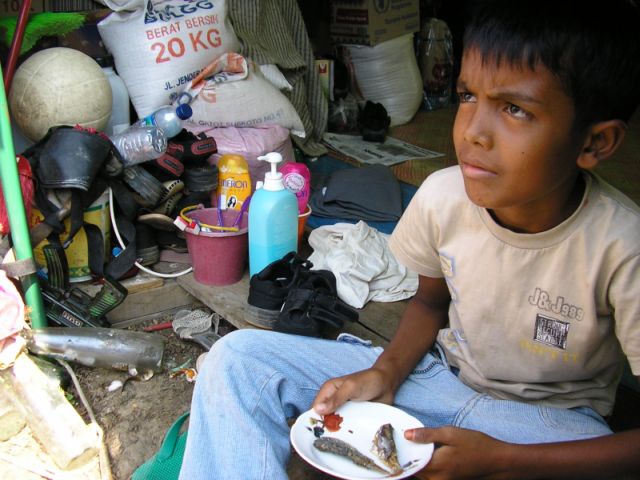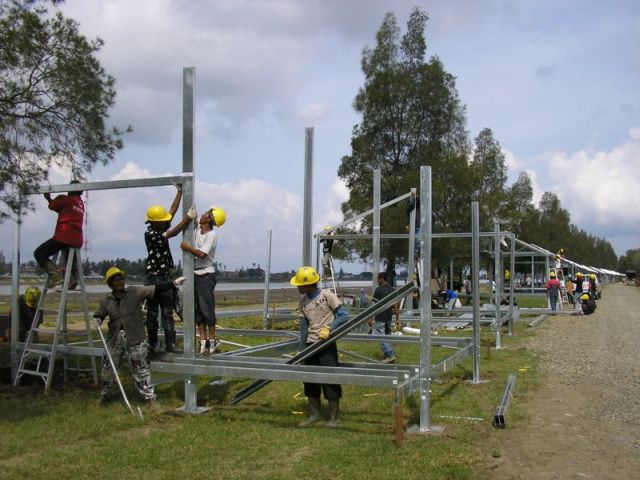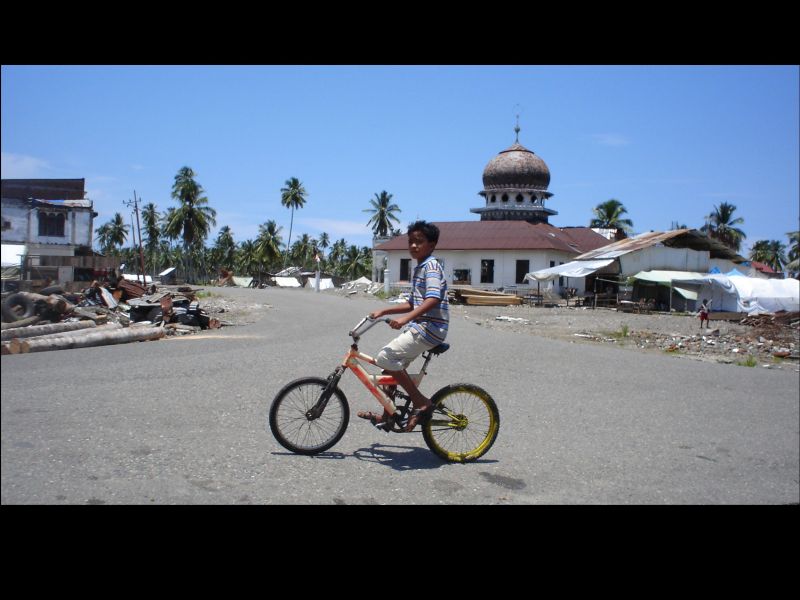Lucy Rhydwen-Marett
Riding through the ruins
|
On my first day in Aceh in mid January 2005, my colleagues and I got in the car and drove to what had once been Ulee Lheu Port in Banda Aceh. We passed the sodden grand mosque, surrounded by pools of stagnant water, and crossed the temporary bridge that had been erected by one of the many militaries that turned up to help. We stopped and I saw fragments of people’s lives amongst the rubble – a pair of kid’s pyjama pants, a whole dinner plate – in a place where no one could possibly have survived. Now when I drive to the port, with all its new houses, down the busy road, past the fish market, I always remember that first trip. There was a very narrow space for a car to fit through, between an endless line of rubble as high as a house. That’s one of the things the TV news couldn’t capture: when you were there, driving for kilometres through rubble and destruction, it seemed never ending.
Resilient survivors
For a month in early 2005 I lived in Calang, on the west coast, where only one building had been left standing. I remember sitting using the wireless internet, on the foundations of what used to be a house, chatting to people back home in Australia. Marvelling at the technology and being able to communicate instantly with friends and family, I tried to capture in words what I was seeing and experiencing: the hot, dusty nothingness, people’s attempts to get on with their lives in a place where so few people had survived. At the same time I experienced a constant sense of guilt about my complicity in the unequal nature of aid work. Although I was sleeping, eating, showering and working in a tent, I was well fed and relatively comfortable. The Acehnese people living in the camps and temporary location centres were not so lucky.
 |
Lunch time at camp Gue Gajah in Banda Aceh, January 2006Niklas Sjögren |
My colleagues at the UN and I visited every temporary location centre for displaced people in the Aceh Jaya district. In those camps I learned my first words of Acehnese: ‘hana ie’, no water. The people we spoke to in the camps told of the construction companies failing to fulfil their contracts and not finishing the wells or the toilets. Without water people couldn’t shower, wash their clothes or flush the toilets.
Some people remained in tents for up to two years, sleeping, cooking and eating under canvas. Others still live in the flimsy temporary location centres, with entire families crammed into a small room with paper-thin walls. While some people have managed to start up small kiosks and other businesses, many others did not have the money or the skills to do this, and still sit around with nothing much to do. Tens of thousands of houses remain unbuilt and many people are still dependent on support that is fast running out, as international NGOs begin to leave Aceh, and the wave of aid dwindles to a trickle.
A landscape remade
From the air, Aceh these days resembles any other part of the beautiful Sumatran coastline, with aquamarine water and white sandy beaches lined with palm trees. For the first year or so after the tsunami, there was a line of brown that stretched down the coast, blanketing the land between the mountains and the shore. Everything on the mountain side of the line was green, everything on the sea side was muddy destruction. More than two years on, the land has regenerated. Trees, shrubs and grass have grown back, and farmers working the land have transformed the muddy mess into rows of chillies, peanuts and watermelons.
As the physical signs of the destruction begin to fade, the emotional wounds left by the disaster are slowly healing. Many of the villages in tsunami affected areas are being renewed, as people move back to regenerate their families and communities. Standing in an area that had been struck by the waves, it is now easy to look around and see all the new houses and roads and feel that everything is back to normal. But there are still physical reminders of the tsunami: I always notice the trees, none of them taller than the new houses they are dotted amongst. They haven’t yet had time to grow.
Not all the changes are so organic. The eerie mass grave by the port, landscaped by the UN, seems oddly out of place with its tidy lawns and odd wind-powered revolving door. Huge swathes of forest have been cleared to make way for the neat rows of houses in the new developments that seem out of line with the higgledy piggledy houses in the parts of town not affected by the tsunami. Some people have refused to move into their new houses because they have no water or power and, because of shoddy construction, are likely to fall down in the next earthquake. In such cases, it appears that the minimum standards of development have not been met.
A new beginning
The changes in Aceh were hard to see when I was living there from 2005 to 2006. Houses went up, but slowly. Markets reopened, and more cars (mainly UN and NGO) arrived on the roads. The waste management project meant all the rubble was cleared away, and the hospitals and schools were reopened. At the time it all seemed frustratingly slow, but things were happening.
 |
Red Cross building temporary sheltersNiklas Sjögren |
These days the pace is still slow, and my friends working in the development sector tell me of their frustration at being caught up in bureaucratic processes. Procedures within the aid organisations can take a painfully long time, but the need to be accountable for donor dollars, and a constant wariness of corruption, make them a necessary part of the reconstruction. It is easy to be critical of the reconstruction effort, but on my last visit in June this year I realised that compared to the ghost town I arrived in back in January 2005, Banda Aceh is thriving.
One of the images that sticks in my mind most from the tsunami is the picture of the Lampuuk mosque, with nothing else around it except rubble and fallen trees. Finding that mosque today is not so easy. Navigating the maze of roads, between the new houses, schools and warungs, past the excited kids playing on the streets, it is almost possible to forget the devastated, muddy mess of two years ago. Finally, these coastal communities are beginning to thrive. ii
Lucy Rhydwen-Marett (lrhydwen-marett@apheda.org.au) is the Project Officer for Aceh and Timor-Leste at Union Aid Abroad (APHEDA), the overseas humanitarian aid agency of the Australian Council of Trade Unions. She worked for two UN agencies in Aceh from January 2005 to March 2006.



